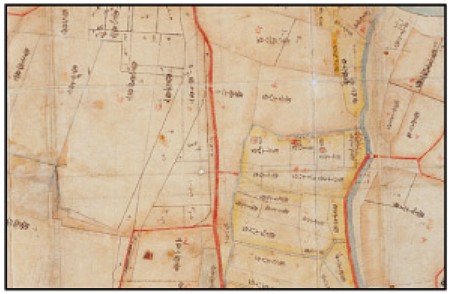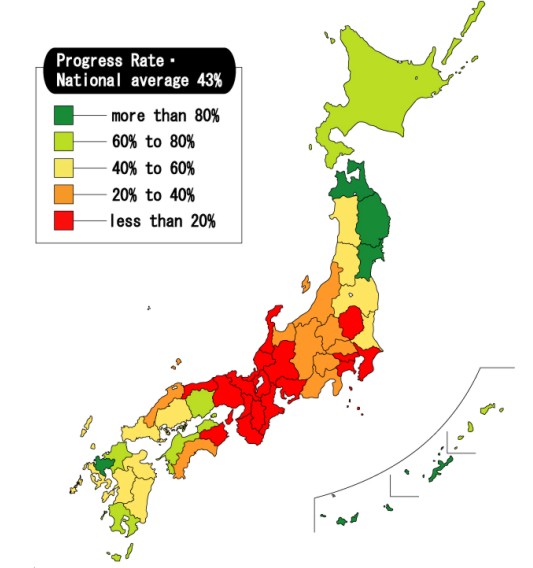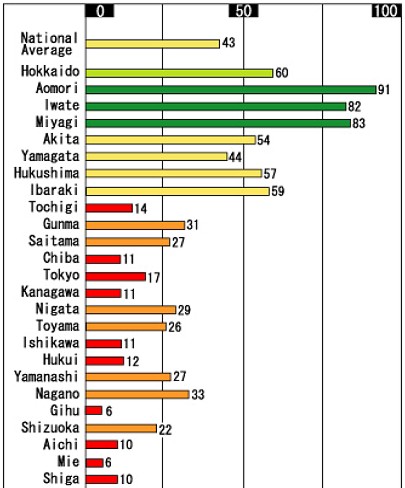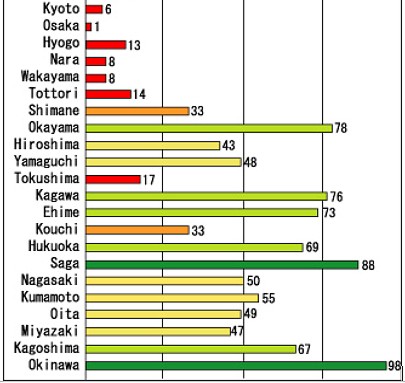THE STATUS REPORT OF REFORMING THE CADASTRE IN JAPANShoichi OKI and Taichi OSHIMA, JapanKey words: Cadastre, National Land Survey, Ten-Year National Land Survey Plan. AbstractThe first cadastre surveying in meaning of the present age in Japan was started in 1873. However, the results are not based on the national geodetic control point network, and accuracy of the dimension and border is not enough, too. The National Land Survey Law was enforced in 1951, and reform of cadastre was started. The Ministry of Land, Infrastructure and Transport (MLIT) has jurisdiction over the reform of cadastre. Then Act on Special Measures for Promotion of the National Land Survey was enforced in 1962, and the national land survey became what was promoted by the Ten-Year National Land Survey Plan. Progress rate until March 2000 is 43%. The fifth Ten-Year National Land Survey Plan was decided in a cabinet meeting in May 2000, and the national land survey entered a new stage. The introduction of a private expert to boundary investigation and the practical use of result of private surveying are planned as a promotion policy. In particular in late years data of boundary of lot is positioned in the national spatial data infrastructure, and it is expected that importance will increase as a constituent of IT. On this account the MLIT does preparations to revise the standard format of numerical cadastre data. In addition, the MLIT does preparations to cope with a revision of the geodetic datum and carries out an examination to introduce RTK-GPS into cadastre surveying. 1. NATIONAL LAND SURVEY1.1 National Land SurveyNational Land Survey has been carried out under provisions in laws mainly National Land Survey Law (Law No.180 of 1951) and The Act on Special Measures for Promotion of National Land Survey (Law No.143 of 1962). National Land Survey aims at improving basic data concerning land of the whole country for more efficient and reasonable land utilization through the scientific and comprehensive survey of actual conditions of the national land and reforming the cadastre. National Land Survey consists of 3 surveys; Cadastral Survey, Land Classification Survey and Water Survey. (1) Cadastral Survey Survey of boundary, dimension, owner, parcel number, and type of land for every parcel of land (2) Land Classification Survey Land Classification Survey conducts a survey of land as to its present utilization, soil class and other physical and chemical quality of soil, erosion and other main natural factors and yields with a view to classifying land according to capability of its utilization and to prepare maps and records based on the data derived from the survey. (3) Water Survey Water survey conducts a survey of water as to its meteorological conditions, quantity of inland water, quality of water, quantity of water transport materials and such mattes concerning water, drainage, water utilization practices and the like with a view to contributing to flood control and water utilization and to prepare maps and records based on the data derived from the survey. 1.2. Cadastral SurveyCadastral survey is one of National Land Survey based on National Land Survey Law. Mainly municipalities conduct Cadastral Survey, surveying owner, parcel number, type of land, boundary and the dimension for every parcel of land The most half of maps kept and utilized at registry office as record concerning land in Japan are still based on old map (recorded map) etc. made at the time of extensive revision of the land taxation system in the Meiji era (the end of 19th century). There are some cases that some recorded map is different from the real boundary and configurations etc., and the dimension of land listed on a registry book is inaccurate. The product of the cadastral survey is submitted to the registry office to update registry books and maps. The updated registry books and maps will be useful for the smooth transaction of interests in land and efficient administration. 1.3. Organizations of Cadastral SurveyThere are three administrative levels in Japan, central government as the national level, the prefecture governments of 47 prefecture and city, town, village offices of 3,200 municipalities. Cadastral Survey is mainly conducted by the local public body like municipalities. The role of the central government is done by Ministry of Land, Infrastructure and transport (MLIT). The MLIT is just started on 6 Jan 2001 after the reconstruction of the system of the central government. Before the reconstruction, the National Land Agency of Prime minister's office has been conducted the role. Main responsibilities of the MLIT are
Main responsibilities of the Prefectures are
Main responsibilities of the municipalities are
Fig. 1.1 Before Survey - a recorded map (Azagiri-zu)
Fig. 1.2 After Survey - a cadastral map
2. PROCEDURE OF CADASTRAL SURVEY(1) Survey Planning (process A, B) The municipality that is conducting the survey makes plans by contacting and adjusting with organs concerned. The municipality has to do the development of an enterprise plan, a public notice of the cadastral survey, the application of a necessary subsidy. The municipality prepares the specifications for their national land survey accordance to the standard specifications established by MILT. Then the municipality official holds a briefing on the survey's substance and necessity for local residents. (2) Basic control point survey The Geographical Survey Institute maintains the 1st to 3rd order control points as the national geodetic control point network. The network is not dense enough for the cadastral survey. The Geographical Survey Institute settles the 4th order basic control point based on the network with the request from municipalities. (3) Geographical control point survey (process C, D) Settle the topographic control point, which is the basic reference of survey. As process C, the triangle survey or the GPS traverse survey is done based on the 4th order basic control points. As process D, the traverse survey mainly using the total station based on the points from process C. Some case, aerial triangulation method is taken to settle these points. (4) The Parcel Investigation (process E) Landowners clarify their own land boundaries for Cadastral Survey. The municipality official in charge visits the actual place referring to data based on an old recorded map etc. The landowners concerning the boundary confirm their land boundaries with mutual agreement. The municipality official also investigates the landowner, parcel number, type of land and so on. Then they put piles along the boundary after the confirmation. The piles display the settled boundaries for each parcel of land. (5) Boundary Survey (process F, G) As process F, surveyors settle the dense topographic control point, and survey to determine the position on earth for each parcel. As process G, after determining the position for each parcel, surveyors make the accurate map (cadastral map) based on each results and measure the dimension. (6) Making Cadastral Record (process H) Integrating results of the Parcel Investigation and Boundary Survey, municipality officials make a draft of cadastral record. The record and map are displayed to the public for 20 days at the municipality. Every person can confirm the results of the cadastral survey. The municipality who has conducted the national land survey may request the president of prefecture to certify the maps and records. The president when he/she has received the request certifies products according to the examination into the products of the national land survey related to the request, unless the products contain a mistake committed in the course of survey in excess for the limit provided for by Cabinet Order. The MLIT obtain in advance the approval of the President. (7) Submit the product of Cadastral Survey to registry office The copies of Cadastral Survey product (the cadastral map and the cadastral record) are submitted to the registry office. The land registry book is revised according to the cadastral record and the old maps are replaced with the new cadastral map officially kept at the registry office. The registry office uses the product of the Cadastral Survey as a material of Immovable Registration in the future. 3. PROGRESS RATE OF CADASTRAL SURVEYCadastral Survey has been conducted since 1951 when National Land Survey Law was established. National Land Survey has been carrying out in accordance with the fourth Ten-Year National Land Survey Plan (fiscal year 1990 to 1999) on the basis of the Act on Special Measures for Promotion of National Land Survey until the end of fiscal year 1999. The progress rate of Cadastral Survey after the fourth plan finished (at the end of fiscal year 1999) stay only 43% of survey-required area and 17% for the urban area. Looking at the progress rate of each prefecture, we can see variation from region to region. Fig. 2 Progress rate
Fig. 3 Progress rate of each prefecture
4. THE TEN-YEAR NATIONAL LAND SURVEY PLANTo promote the national land survey, the Act on Special Measures for Promotion of National Land Survey amended in March 2000. The cabinet meeting approved starting for the fifth Ten-Year National Land Survey Plan from fiscal year 2000 in May 2000. The fifth plan aim at promoting to execute the national land survey urgently and systematically. The full content of the Ten-year National Land Survey Plan is as follows. Ten-Year National Land Survey Plan The Ten-Year National Land Survey Plan shall be provided for in article 3 paragraph 1 of the Act on Special Measures for Promotion of National Land Survey (Law No.143 of 1962) as follows.
Moreover, Cadastral Survey shall be improved with utilizing private ability and result. And, this plan shall be taken into consideration in the middle term, if necessary, observing social and economic trend and financial situations etc. in the future. 5. PROMOTION POLICIESTo promote the cadastral survey along the plan, four following promotion policies are introduced. (1) The practical use of private specialist in a parcel investigation A principle that the official staff of the city, towns and villages carries out a parcel investigation by oneself is switched. Private specialists are introduced to promote a survey positively. (2) The Intensive survey in the urban district In the urban district, a budget is preponderantly distributed for the city to promote a cadastral survey and, a cadastral survey is entrusted the third sector with comprehensively to execute a cadastral survey intensively in a short term. (3) The flexible confirmation of border Landowners must be present at the confirmation of border as a principle. The system is used flexibly. Confirming by using photographs, surveyed maps, etc. signed mail from landowner can be used for confirmation of border. (4) The simple survey with private results The simple cadastral survey using private results is introduced. Private estate development done with the constant accuracy is introduced into a cadastral survey to decrease some process. 6. TREND OF THE CADASTRAL SURVEY IN JAPAN(1) Introduce the RTK-GPS GPS survey is already introduced into the cadastral survey. Most of the process C is done with the static GPS method. To introduce the RTK-GPS method within the process D and F, the MLIT has carried out a GPS campaign in autumn of 2000. Now the MLIT is discussing to revise the standard specification of the cadastral survey to fix with the RTK-GPS method. (2) Cadastral data as basis of the IT Central government organizes a GIS committee. The committee positioned the data of the parcel boundary in the National Spatial Data Infrastructure. It is expected that importance will increase as a constituent of IT. On this account the MLIT does preparations to revise the standard data format of numerical cadastre data. From fiscal 1998, The MLIT has organized an investigation committee to discuss the new format. In March 2001, the committee had submitted a final report. The draft of the new format and data converter from the current format to the new format are fixed. The MLIT is going to authorize the format soon. (3) The new geodetic datum of Japan The MLIT does preparations to revise the geodetic datum of Japan. The current datum is the Tokyo datum constructed by Japan Army Survey in the 19th century. The new datum "JGD2000: Japan Geodetic Datum 2000" is based on ITRF94. The Kashima VLBI station is connected with the ITRF with the international VLBI survey. Three domestic VLBI stations were fixed with the Kashima VLBI station with the domestic VLBI survey. Fixed GPS stations make the strong network held fixed with these VLBI stations. All the geodetic control stations are re-surveyed or re-calculated held fixed the GPS stations. The 4th order basic control stations for the cadastral survey are also re-calculated by the interpolation method. In some area, the re-calculated results are not harmonized with re-surveyed data because of the crustal deformation or land subsidence. The MLIT is re-surveying these 4th order control points. 7. CONCLUDING REMARKSReforming the cadastre in Japan has been continuing more than fifty years. Half of the maps at the registry office are still not based on the national geodetic control network. These maps dose not have a function of the cadastral map. Land registration is still handled with the paper base method. Numerical cadaster could not be introduced into the system of the land register. It is strongly requested that the reforming the cadastre should be finished soon to shift the modern cadastre. BIOGRAPHICAL NOTEShoichi Oki's, academic background is geophysics especially analysis of plasma waves in space by Very Long Baseline Interferometry (VLBI) survey. He joined after graduate from the university business with Geographical Survey Institute (GSI). He conducted geodetic survey, topographic mapping and digital mapping. During 1991 to 1993 he was transferred temporarily to the National Land Agency as a chief of National Land Information Office. During 1996 to 1997 he stayed in Germany as a guest scientist of Technical University Munich to research digital photogrammetry. During 1997 to 1998 he worked to establish International VLBI Service as the VLBI group leader of GSI. He participated in basic survey planning and system reforming of survey as a member of strategic planning team of GSI. In 2000 he was prompted to the Deputy Director for cadastral survey of the National Land Agency. He has shift to Ministry of Land, Infrastructure and Transport after reconstruction of government system of Japan. Taichi Oshima got Dr. Eng. Degree from University of Tokyo
and he had been engaging in research and teaching in University of
Tokyo, Institute of Industrial Science for 26 years and Hosei
University for 20 years. Besides that academic career, he had given
lectures in several national and private universities. He has also
involved in International Meeting and Symposium as a speaker and
session chairman. CONTACTShoichi OKI Taichi OSHIMA 20 April 2001 This page is maintained by the FIG Office. Last revised on 15-03-16. |




